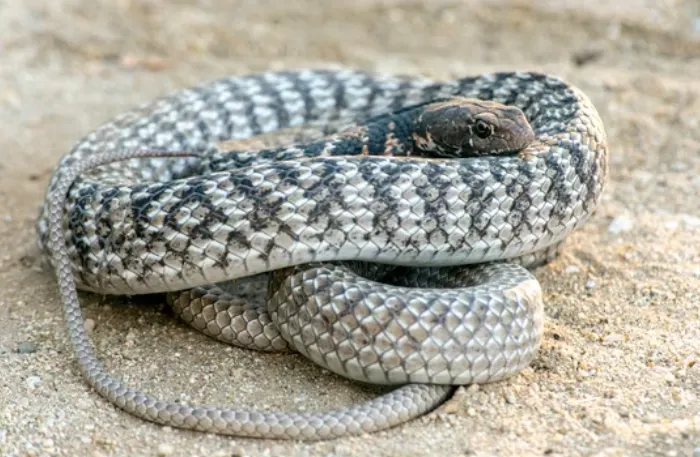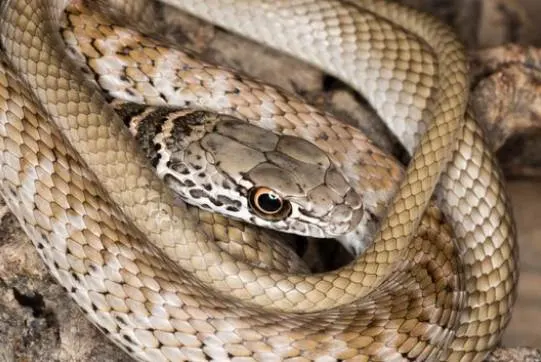The coachwhip snake, scientifically known as Masticophis flagellum, is a remarkable reptile native to the Americas, recognized for its incredible speed, unique appearance, and misunderstood reputation. Found throughout the southern United States, Mexico, and parts of Central America, this non-venomous snake is often spotted by hikers, nature enthusiasts, and those who dwell near its natural habitats. In this blog, we will explore the characteristics, behavior, habitat, and fascinating facts about the coachwhip snake, shedding light on why this species is a true marvel of the reptilian world.

Table of Contents
Physical Characteristics
The coachwhip snake is known for its long, slender body, which can reach lengths of up to eight feet, making it one of the longest snakes in North America. Its name comes from its distinct appearance, as the scales on its body resemble a braided whip, particularly around the tail. The coloration of the coachwhip varies widely, depending on the subspecies and geographic location. It typically has a dark-colored head, which gradually lightens to a tan or white tail. Some coachwhips are almost entirely tan, while others may have reddish or pink hues, especially in regions like the southeastern United States.
One of the most striking features of the coachwhip snake is its large eyes, which give it excellent vision, a crucial trait for a diurnal hunter that relies on sight to track down its prey. These snakes are also known for their agility and speed, capable of moving up to four miles per hour, which is remarkably fast for a snake.
Habitat and Distribution
Coachwhip snakes are highly adaptable and can thrive in various environments, from prairies and sandhills to coastal dunes and open pine forests. They prefer areas with loose, sandy soil where they can easily burrow to escape predators or extreme weather conditions. These snakes are most commonly found in the southern United States, from Florida and Texas to Arizona and California. Their range extends into northern Mexico, and some populations are found as far south as Central America.
The coachwhip is most active during the day, especially during the hottest hours, which is why it is often spotted basking in the sun or swiftly moving across open ground in search of prey. During the cooler months, coachwhips will hibernate, typically seeking shelter in underground burrows or beneath rocks and debris.
Diet and Hunting Behavior
Coachwhip snakes are carnivorous and have a diverse diet that includes small mammals, birds, lizards, frogs, and insects. Unlike many other snakes that rely on ambush tactics, coachwhips are active hunters. They use their keen eyesight to locate prey and their speed to chase it down. Once they have captured their prey, they typically swallow it whole, alive or dead, without using venom or constriction.
This hunting strategy is quite different from that of many other snakes, which often rely on stealth and patience. The coachwhip’s active hunting style and broad diet allow it to occupy a variety of ecological niches, contributing to its wide distribution across the Americas.
Reproduction and Lifespan
The breeding season for coachwhip snakes usually occurs in late spring and summer. During this time, male coachwhips become territorial and will defend their hunting grounds from rivals to protect any nearby females. Females may mate with multiple males and will lay between 4 to 24 eggs in a burrow or other secluded location. The eggs take about two months to hatch, and the young snakes are independent from birth.
In the wild, coachwhip snakes typically live for about 13 years, although they can live longer in captivity, with some individuals reaching up to 20 years of age. Their lifespan in the wild is often shortened by predators such as birds of prey, coyotes, and other larger animals. However, their speed and agility provide them with a significant advantage when it comes to evading threats.
Myths and Misconceptions
The coachwhip snake has long been the subject of various myths and misconceptions, particularly among those unfamiliar with its behavior. One common myth is that the coachwhip will chase people and attempt to whip them with its tail. This is entirely false; coachwhips are non-aggressive snakes that prefer to flee rather than fight when threatened. If cornered, they may stand up and strike in self-defense, but their bites are non-venomous and generally not harmful to humans.
Another persistent myth is that coachwhip snakes will suckle milk from livestock, particularly cows. This myth likely arose from the snake’s presence around farms, where it was seen hunting rodents and other pests. There is no truth to this tale, and like other snakes, coachwhips lack the physical ability to nurse from mammals.

Conservation Status and Human Interaction
According to the International Union for Conservation of Nature (IUCN), the coachwhip snake is classified as a species of “Least Concern.” While their populations are stable across most of their range, habitat loss and road mortality have caused declines in some localized areas. For example, in Illinois, the coachwhip is considered endangered due to habitat fragmentation and human activity.
Despite their harmless nature, coachwhip snakes are often killed by humans out of fear or misunderstanding. Education and awareness are key to ensuring that these snakes are protected and appreciated for their role in the ecosystem. Coachwhips help control populations of rodents and other small animals, making them an important part of the natural
The coachwhip snake is a fascinating species that combines speed, agility, and a unique appearance, making it one of the most interesting reptiles in the Americas. Despite the myths and misconceptions that surround it, the coachwhip is a non-venomous and generally non-aggressive snake that poses little threat to humans. By understanding more about this remarkable snake, we can better appreciate the diversity of life in our natural world and the importance of conserving the habitats where these creatures thrive.
- Enchi Ball Python: A Unique and Stunning Morph of Python regius - March 27, 2025
- Emerald Tree Monitor: The Enigmatic Green Guardian of the Rainforest - March 26, 2025
- The Egyptian Cobra (Naja haje): A Fascinating Serpent - March 25, 2025
